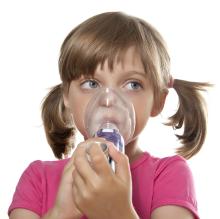Asthma Basics
Asthma is a disease that affects a person’s breathing and can reduce the body’s ability to get oxygen to the lungs. With asthma, the inner lining of the airways can swell or become irritated and inflamed. When this happens, the person may cough or wheeze. There isn’t a cure for asthma, but it can be managed.
For children with asthma, communication is especially important to manage the disease. Parents or caregivers, doctors, school nurses, and teachers should all follow the steps outlined in a child’s asthma action plan to manage their asthma symptoms, triggers, and attacks.
Before your next doctor appointment, review this fact sheet, How to Talk With Your Doctor About Asthma, P-03558, (available in English and Spanish) to make sure you get all of the information you need to manage your asthma.
Although the exact cause of asthma is unknown, there are factors that can increase a person’s risk of developing the condition. These include:
- Genetics—If someone in your family has asthma or allergies, your risk of developing asthma increases.
- Early exposure—If you’re exposed to tobacco smoke, certain allergens, or viral infections at a young age, you’re more likely to develop asthma.
Although their severity and frequency vary, here are a few common asthma symptoms:
- Chest tightness
- Intermittent cough
- Shortness of breath
- Wheezing
There are several things that can cause an asthma attack. Some of the most common triggers include:
- Outdoor air pollution (ground-level ozone, tiny particles, toxic air emissions)
- Chemicals in scented or cleaning products
- Exercise
- Dust mites
- Mold
- Pests (cockroaches, mice)
- Pets (skin, hair, saliva, feathers)
- Pollen (grasses, trees, flowers)
- Viral infections (colds, flu, COVID-19)
- Strong emotions (crying, laughing, stress)
- Strong odors
- Tobacco smoke, which is the No. 1 preventable trigger of asthma
- Weather (cold or dry air, high humidity, extreme temperature changes)
Reducing or getting rid of asthma triggers can prevent asthma symptoms and decrease their severity.
- Avoid asthma triggers.
- Develop an asthma action plan with your doctor or health-care provider, and follow it every day.
- Take asthma medicine as prescribed.
- Get an annual flu vaccine.
- Get a COVID-19 vaccine and boosters as recommended.
- Go to vaccineinformation.org to find a vaccine near you.
Learn why it is important to have an asthma action plan for your child at school. Find asthma action plans in several languages.
If you care for a child with asthma, here are some tips to keep them safe at school:
- Make sure your child takes their medicine as prescribed every day.
- Give a copy of your child’s asthma action plan to their teachers and school nurse.
- Give the school nurse or teachers their labeled medicine with instructions on how and when to give it.
- Fill out school health forms, including emergency contacts. If your child can self-administer medications, fill out a school permission form stating they can take their asthma meds as needed without supervision.
- Review the asthma action plan and the school’s emergency treatment process with your child.
- Make sure your child gets a flu shot every fall.
Hear from Wisconsin School Nurse, Charonda Farrington, as she discusses asthma in schools and why it is so important for students with asthma to have an Asthma Action Plan and a rescue medication/inhaler at school.
Many people work with materials or in situations that can worsen their existing asthma (work-exacerbated asthma) or even lead them to develop asthma for the first time (occupational or work-related asthma). Learn about work-related asthma, P-03684 (PDF). Knowing how work can affect your asthma risk and what you can do about it is important for workers as well as employers and healthcare workers. You can find more information through the resources below.

